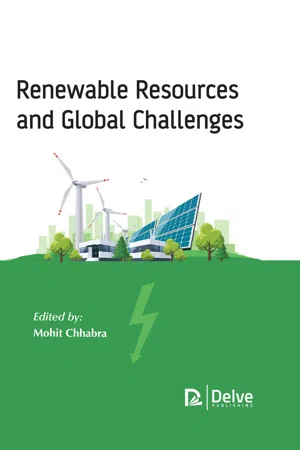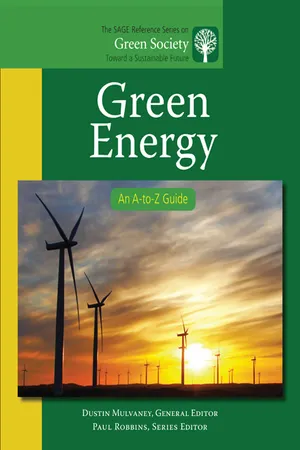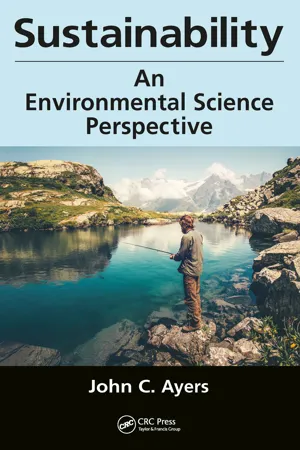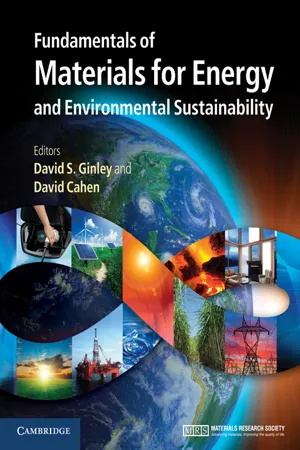Geography
Non Renewable Energy Sources
Non-renewable energy sources are natural resources that cannot be replenished within a short period of time. These include fossil fuels like coal, oil, and natural gas, as well as nuclear energy. Non-renewable energy sources are finite and contribute to environmental pollution and climate change. As a result, there is a growing emphasis on transitioning to renewable energy alternatives.
Written by Perlego with AI-assistance
Related key terms
1 of 5
10 Key excerpts on "Non Renewable Energy Sources"
- eBook - PDF
- Mohit Chhabra(Author)
- 2019(Publication Date)
- Delve Publishing(Publisher)
If the people do not replant biomass feedstocks as quick as they make use of them, then the biomass energy, on the other hand, becomes a non-renewable energy source. Renewable Resources and Global Challenges 196 Figure 7.7: Biomass is being used more often as a source of energy. Source: https://s0.geograph.org.uk/geophotos/02/99/35/2993546_c2ca0051. jpg 7.5. SOCIAL IMPACT OF NON-RENEWABLE RE-SOURCES OF ENERGY The major part of the energy is drained out from the Earth. This energy is drained out from the sources of fuel that are present in the form of fuels. These resources are the non-renewable resources of energy. The dependence of the modern society has increased exponentially on the mineral and fossil fuel, which are mainly derived from the non-renewable energy sources. There is a difference in the availability, cost of production, and geological and economical distribution of the non-renewable resources of energy. Even though the solid fuels, the energy resources of the fossil fuels and the mineral commodities are non-renewable in nature (Figure 7.8). Non-Renewable Resources and the Issues 197 Figure 7.8: There are many social impacts of the non-renewable resources of energy. Source: https://upload.wikimedia.org/wikipedia/commons/thumb/d/ dd/Protest_against_Dakota_Access_and_Keystone_XL_Pipe-lines_20170126-1638.jpg/1024px-Protest_against_Dakota_Access_and_ Keystone_XL_Pipelines_20170126-1638.jpg Still, the metals that are extracted from these sources have the capability to be used again and again. But there is a limit for the recycled use of the energy that is extracted from these sources of energy. Although, there are many studies that have indicated that the stock of the secondary resources of the non-renewable resources of energy has depleted in past few years. On the other hand, the use of these non-renewable resources has increased. Still, the world needs some alternate to this kind of resources, and similar need will be displayed in the future. - eBook - PDF
- Barbara W. Murck, Brian J. Skinner(Authors)
- 2016(Publication Date)
- Wiley(Publisher)
450 Chapter 16 understanding Earth’s Resources biggest energy consumers (Figure 16.3). Whereas soil and water were the most critical nonrenewable resources for earlier civilizations, our society’s weakest link may be its excessive dependence on nonrenewable energy sources. How and whether we can reduce this dependence is both a political problem and a social problem. Geology plays an important role in three ways: identifying new supplies of traditional resources, allowing us to estimate how much we have left, and evaluating the consequences of using new and unconventional resources. How much energy do we use? • Figure 16.3 Per capita energy use differs dramatically from one country to another. Ea[`Y]d Fa[`gdk'F? AeY_] ;gdd][lagf BYe]k H& :dYaj'F? AeY_] ;gdd][lagf Y& 9f Yn]jY_] 9e]ja[Yf mk]k ]f]j_q$ \aj][ldq gj af\aj][ldq$ Yl Y jYl] ]imanYd]fl lg Zmjfaf_ )-( /-%oYll da_`l ZmdZk ]n]jq eaf% ml] g^ ]n]jq \Yq& ;YfY\aYfk$ oal` l`]aj [gd\ oafl]jk$ mk] ]n]f egj] ]f]j_q&! @]j] Y `a_`oYq ka_f Y\egfak`]k Dgk 9f_]d]k [geeml]jk$ Ƈ - eBook - PDF
Green Energy
An A-to-Z Guide
- Dustin Mulvaney, Dustin R. Mulvaney(Authors)
- 2010(Publication Date)
- SAGE Publications, Inc(Publisher)
Nashville, Tennessee. Thornton, Jeffrey A., Walter Rast, Marjorie M. Holland, Geza Jolankai, and Sven-Olof Ryding. eds. Assessment and Control of Nonpoint Source Pollution of Aquatic Ecosystems: A Practical Approach. Pearl River, NY: Parthenon Publishing Group, 1999. U.S. Environmental Protection Agency. “National Management Measures to Control Nonpoint Source Pollution from Agriculture.” Document No. EPA 841-B-03-004 (July 2003). U.S. Environmental Protection Agency. “2000 National Water Quality Inventory.” Washington, D.C.: U.S. Environmental Protection Agency, Office of Water, 2002. http:// www.epa.gov/305b/2000report (Accessed February 2009). Sudhanshu Sekhar Panda Gainesville State College N ONRENEWABLE E NERGY R ESOURCES Energy is commonly referred to as the ability to do work; it enhances man’s ability to convert raw materials to useful products. Energy is of two forms and sources; namely, 308 Nonrenewable Energy Resources renewable and nonrenewable sources of energy. The renewable energy resources are those that are naturally generated and can be obtained from the sun, water, winds, waves, tidal, and other replenishing natural sources. These resources are nondepleting, abundantly available, and naturally occurring. The nonrenewable energy resources are those sources that cannot be replenished by natural phenomenon over a short period of time. They account for over 75 percent of the energy sources used worldwide. Nonrenewable energy sources are those sources that have been formed over many millions of years; they natu-rally exist and are organic in nature—mostly plants and animals that died millions of years ago and thus have fully decomposed, releasing all their carbon contents back to the Earth and becoming a usable source of useful energy. They emanate from the ground either as liquids (e.g., crude oil), solids (e.g., coal), or gases (e.g., associated and nonassociated gases) and exist in fixed amounts per location. - eBook - PDF
Our Energy Future
Introduction to Renewable Energy and Biofuels
- Carla S. Jones, Stephen P. Mayfield(Authors)
- 2016(Publication Date)
- University of California Press(Publisher)
Consider the wind. Humans have used wind power for many centuries, yet there is no shortage of wind today. Wind is created from the heat of the sun on Earth; it is constantly produced and the Earth’s generation of wind is not directly impacted by human activity. Thus, wind is both renewable and sustainable. Fossil fuels, while naturally created, cannot be sustained in the face of rapidly increasing consumption and therefore cannot be guaran-teed to be an available resource in the future. In addition, as you learned previously, fossil fuels take millions of years to develop, meaning these resources cannot be replaced in a short period of time; therefore, fossil fuels are both non-sustainable and nonrenewable. The development of an ideal energy resource to replace fossil fuels will need to be both renewable and sustainable to support all generations in the future and maintain environmental quality. All of the energy that is consumed today, regardless of whether it is from a finite or infinite resource, comes from only one of three primary energy sources : the sun, the moon, or the core of the Earth. For example, fossil fuels, which are a product of millions of years of decayed plant matter, are ultimately derived from the sun since plants capture solar energy through photosynthesis. As other renewable energy sources like water, wind, waves, and tides are discussed, it is important to remember that they can all be tracked back to one of these three primary energy sources. Two of these primary energy sources, the sun and the core of the Earth, generate their energy through thermo-nuclear reactions . Thermonuclear reactions involve the combination or dissociation of atomic nuclei, either of which results in the release of large amounts of energy. These reactions are classified as either nuclear fission reac-tions when the nuclei dissociate (i.e., break apart) or nuclear fusion reactions when two atomic nuclei combine (i.e., fuse). - eBook - ePub
Sustainability
An Environmental Science Perspective
- John C. Ayers(Author)
- 2017(Publication Date)
- CRC Press(Publisher)
9 Nonrenewable Energy SourcesEnergy may be our most important resource, and energy availability will likely be the ultimate limit on population and economic growth. Abundant energy makes it easy to be sustainable because it can be used to produce essential resources such as food and potable water where they are scarce. However, many areas of the world are experiencing energy shortages. Furthermore, 88% of the world’s energy comes from burning fossil fuels, which adds the greenhouse gas carbon dioxide to the atmosphere, intensifying global climate change (Princen, Manno, and Martin 2013). The fossil fuel era began when fossil fuels surpassed wood as the dominant energy source, but it is not permanent. To become sustainable, our society must transition from nonrenewable fossil fuels to renewable energy sources. Having covered oil in Chapter 6 , we will review sustainability issues associated with the remaining nonrenewable energy sources in this chapter before reviewing renewable energy sources in Chapter 10 . In Chapter 11 we will compare the costs of these energy sources and review policy options.9.1 IntroductionEnergy comes in many forms, including chemical, mechanical, electrical, heat, and light. We use energy to perform work, usually by converting it from one form that stores it to another. For example, fossil fuels and electrochemical batteries store chemical energy. To propel conventional autos that have internal combustion engines we burn gasoline or diesel to convert the stored chemical energy to mechanical energy. Electric cars convert chemical energy stored in electrochemical batteries to mechanical energy, with the added advantage that they don’t emit carbon dioxide.Some forms of energy are more useful than others. Heat is considered low quality energy because it is dispersed. Electricity is a high quality form of energy because we can transport it through conductive wires, store it in batteries, and use it to make other forms of energy. We also can use it for electronic communication, which makes it indispensable to modern society. As a result, we typically convert other forms of energy to electricity. For example, mechanical energy in flowing water or steam is converted to electrical energy using a turbine. According to the second law of thermodynamics, each time we convert other forms of energy to electricity we lose some energy, but the increased utility of electricity balances this loss. - eBook - PDF
World Energy Supply
Resources - Technologies - Perspectives
- Manfred Grathwohl, Mary Brewer(Authors)
- 2018(Publication Date)
- De Gruyter(Publisher)
3. The World's Energy Potential 3.1 The basic types of available energy There are basically two types of energy source available to meet the energy demands of humanity: those which are found in the earth's crust (fossil and nuclear fuels) and are not renewable, and those which are continuously available (solar, tidal and geothermal energy), and are thus classified as renewable sources (compare Fig. 3-1). Over the time span covered by human civilization, these sources can be considered constant (see 3.37, 3.38 and 3.39). Fossil fuels include peat, brown (lignite) coal, anthracite coal, petroleum, natural gas, oil shales and oil sands. The fissionable nuclear fuels are uranium and thorium, and the fuels for fusion are deuterium and lithium. Solar energy is available in many forms; even fossil fuels are none other than solar energy which has been stored for millions of years. (It is nonetheless conventional to regard these nonrenewable fuels separately from the other forms of solar energy). Radiant energy from the sun warms the earth and provides energy for the photosyn-thesis of biomass and free oxygen, and thus makes life possible on earth. Without solar energy, there would be no water power, wave energy, ocean heat or currents, or wind energy. Sunlight can be converted to other forms, for example by solar thermal, photoelectric or photochemical conversion. Ignoring, for the moment, technological and ecological problems, we can see that the long-term options for energy supply derive from the division of energy sources into renewable and non-re-newable types. Solar and geothermal energy, as continuous flows of energy, are two options for an unlimited supply of energy. (The flow of energy in the tides is small compared to the previous two; compare Table 3-3 and Fig. 3-11). In the sun, 10 38 helium nuclei are formed from protons each second. - eBook - PDF
- G. Miller, Scott Spoolman(Authors)
- 2020(Publication Date)
- Cengage Learning EMEA(Publisher)
Like any technology, this approach has advantages and disadvantages that we discuss later in this chapter. In this chapter, we explore and compare the benefits and drawbacks of using nonrenewable energy resources fossil fuels, such as oil, natural gas, coal, and nuclear power. In the next chapter, we look at the advantages and disadvantages of improving energy efficiency and using a variety of renewable energy resources. ● CORE CASE STUDY FIGURE 15.1 Fracking: Horizontal drilling and hydraulic fracturing are used to release large amounts of oil and natural gas that are tightly held in underground shale rock formations. Natural gas wellhead Wastewater strorage pond Pipeline detail Water pump truck Water and sand Oil or gas Oil wellhead Deep aquifer Shallow aquifer Natural gas in shale rock Oil in shale rock Copyright 2021 Cengage Learning. All Rights Reserved. May not be copied, scanned, or duplicated, in whole or in part. Due to electronic rights, some third party content may be suppressed from the eBook and/or eChapter(s). Editorial review has deemed that any suppressed content does not materially affect the overall learning experience. Cengage Learning reserves the right to remove additional content at any time if subsequent rights restrictions require it. Section 15.1 353 In 2017, 85% of the world’s commercial energy and 80% of U.S. commercial energy came from nonrenewable resources (mostly oil, natural gas, and coal), while the rest came from renewable resources (Figure 15.2) 15.1 ENERGY RESOURCES LO 15.1A Explain the difference between renewable and nonrenewable energy resources, using three examples of each. LO 15.1B Explain how net energy for any energy resource is calculated. LO 15.1C Explain why it is important to calculate the net energy for any energy resource. LO 15.1D List three energy sources with low net energies and three energy sources with high net energies. LO 15.1E Explain why electricity produced by nuclear power has a low net energy. - eBook - PDF
The Blue Planet
An Introduction to Earth System Science
- Brian J. Skinner, Barbara W. Murck(Authors)
- 2011(Publication Date)
- Wiley(Publisher)
Further concerns arise from issues of national security and from the need to import oil from politically unstable regions. In the meantime, as dwindling supplies of fossil fuels drive prices up, more attention will be paid to enhancing energy efficiency, the amount of energy consumed per unit of productive out- put. The energy efficiency of technologies used in indus- trialized countries has been increasing (that is, less energy is being used to accomplish the same tasks) over the past decade or so. If we can manage to move beyond our dependence on fossil fuels, it is clear that there are numerous sources of 568 PART SIX • THE ANTHROPOSPHERE: HUMANS AND THE EARTH SYSTEM for alternative, renewable, or inexhaustible sources of energy to fill a greater proportion of our energy needs. In the next and final chapter of the book we will look broadly at some of the changes that human activ- ity is causing in Earth systems, including the scale, degree, and reversibility of these changes. energy available to us from various sources in the Earth system—far more energy than we can use. What is not yet clear is when, or even whether, we will be clever enough to learn how to tap these energy sources in ways that will not disrupt the environment and endanger the future availability of resources. It makes sense to look 80° 20° 80° 0° 0° 0° 60° 60° 80° 60° 60° 40° 40° 20° 80° 60° 60° 40° 40° 20° 20° 120° 120° 180° 180° Areas underlain by sedimentary rock. In the ocean to a depth of 2000 m. Areas of ocean deeper than 2000 m underlain by thick accumulations of sedimentary rocks. Areas where major amounts of oil and gas have been found. FIGURE 18.25 How much oil is left? This map shows areas underlain by sedimentary rock and regions where large accumulations of oil and gas have been located. Where the ocean is deeper than 2000 m, sedimentary rock has yet to be tested for oil and gas potential. - eBook - PDF
- G. Miller, Scott Spoolman(Authors)
- 2014(Publication Date)
- Cengage Learning EMEA(Publisher)
Most of the increase has occurred in rapidly developing countries such as China, India, South Korea, and Brazil. 9-1 What Is Net Energy, and Why Is It Important? CONCEPT 9-1 Energy resources vary greatly in their net energy yields —the amount of high-quality energy available from an energy resource minus the amount of energy needed to make it available. ▲ Oil drilling platform Oil well Gas well Natural gas Underground coal mine Impervious rock Water Water Water is heated and brought up as dry steam or wet steam Hot rock Magma Oil Pump Pipeline Pipeline Geothermal power plant Contour strip mining Area strip mining Mined coal Drilling tower Water penetrates down through the rock Coal Geothermal energy Oil and natural gas Coal seam Oil storage Hot water storage Figure 9-1 Natural capital :Importantnonrenewableenergyresourcesthatcanberemovedfromtheearth’scrustarecoal,oil,naturalgas, andsomeformsofgeothermalenergy.Nonrenewableuraniumoreisalsoextractedfromtheearth’scrustandprocessedtoincreaseitsconcen-trationofuranium-235,whichcanserveasafuelinnuclearreactorstoproduceelectricity. Question :Canyouthinkofatimeduringatypical daywhenyouarenotdirectlyorindirectlyusingoneoftheseresources? Unless otherwise noted, all art on this page is © Cengage Learning 2015. Copyright 201 Cengage Learning. All Rights Reserved. May not be copied, scanned, or duplicated, in whole or in part. Due to electronic rights, some third party content may be suppressed from the eBook and/or eChapter(s). Editorial review has deemed that any suppressed content does not materially affect the overall learning experience. Cengage Learning reserves the right to remove additional content at any time if subsequent rights restrictions require it. 190 CHAPTER 9 NonrenewableEnergyResources Net Energy is The Only Energy That Really Counts It takes energy to get energy. - David S. Ginley, David Cahen(Authors)
- 2011(Publication Date)
- Cambridge University Press(Publisher)
PART 2 Nonrenewable energy sources 9 Petroleum and natural gas Russell R. Chianelli, 1 Xiomara C. Kretschmer, 1 and Stephen A. Holditch 2 1 University of Texas at El Paso, El Paso, TX, USA. 2 Texas A&M University, College Station, TX, USA 9.1 Focus Petroleum and natural gas have been the mainstay of energy pro- duction in developed countries. Global energy demand will con- tinue to increase with “globaliza- tion.” Oil and natural gas will continue to supply a majority of our energy in the near future and production will be from natural sources of petroleum, coal, and natural gas. For example, Energy Independence has reported that the USA has an estimated 260 bil- lion tons of recoverable coal, equivalent to three or four times as much energy in coal as Saudi Arabia has in oil [1]. The needed increase requires the exploitation of conventional and unconventional reservoirs of oil and gas in an “ environ- mentally friendly” manner. This necessitates advances in materials in the form of better catalysts to produce clean fuels and advanced materials for high-pressure, high-temperature, and high-stress processes. 9.2 Synopsis The National Petroleum Council (NPC) in the USA recently published a report entitled Facing the Hard Truths about Energy that evaluates oil and gas supply and demand in the early part of the twenty-first century [2]. The report concluded that the total global demand for energy will grow by 50%–60% by 2030 due to the increase in world population and higher average standards of living in some developing countries. Clearly, for the next few decades, oil, gas, and coal will continue to be the primary energy sources. The energy industry will have to continue increasing the supply of hydrocarbon fuels to meet the global energy demand. There are ample hydrocarbon resources to meet the demand well into the twenty-first century.
Index pages curate the most relevant extracts from our library of academic textbooks. They’ve been created using an in-house natural language model (NLM), each adding context and meaning to key research topics.









